How to Clean Firearms: A Step-by-Step Basic Guide
The maintenance of firearms is a crucial aspect of gun ownership, ensuring both safety and longevity of these intricate machines. In this comprehensive guide, we will walk through the basics of firearm cleaning, emphasizing the importance of regular upkeep. This isn’t just about presenting a method; it’s about fostering an understanding and respect for the process, ensuring your firearm remains in pristine condition for years to come.
Choosing Your Cleaning Kit
Selecting the Right Container
A reliable cleaning kit is a cornerstone of effective firearm upkeep. Selecting a robust, easily transportable container ensures that your cleaning tools are neatly organized and within reach whenever you need them.
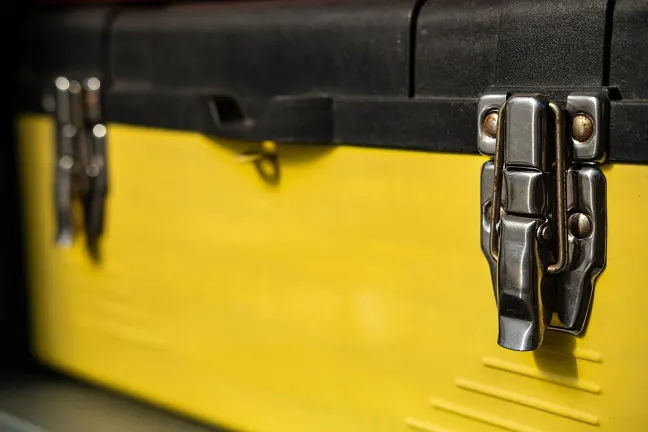
Whether you choose a specially designed cleaning kit case or a creatively repurposed item like a fishing tackle box, the goal is to have a dedicated space that safeguards your cleaning essentials, making the maintenance process streamlined and efficient.
Essential Tools for Your Kit
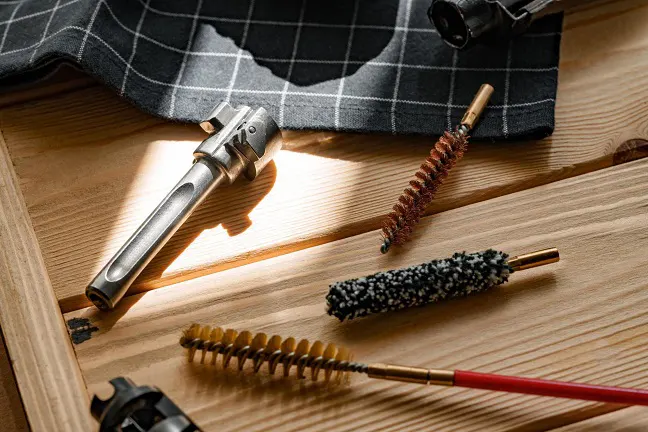
Building a comprehensive cleaning kit is foundational to effective firearm maintenance. It should include sturdy cleaning rods to facilitate the smooth passage of patches through the barrel, varied bore brushes to suit different calibers for thorough barrel cleaning, a general-purpose cleaning brush for surface grime, and the indispensable CLP for its multifaceted role in cleaning, lubricating, and preserving your firearm. Additionally, q-tips and pipe cleaners are invaluable for reaching intricate spaces, while cleaning patches are essential for wiping down and polishing all components.
Cleaning Solutions and Products
Understanding CLP
The versatility of CLP, standing for Cleaner, Lubricant, Preservative, makes it a staple in any firearm cleaning regimen. Its multi-purpose formula is designed to effectively remove fouling, provide essential lubrication to moving parts, and offer a protective layer against rust, simplifying the cleaning process while ensuring comprehensive care for your firearm.
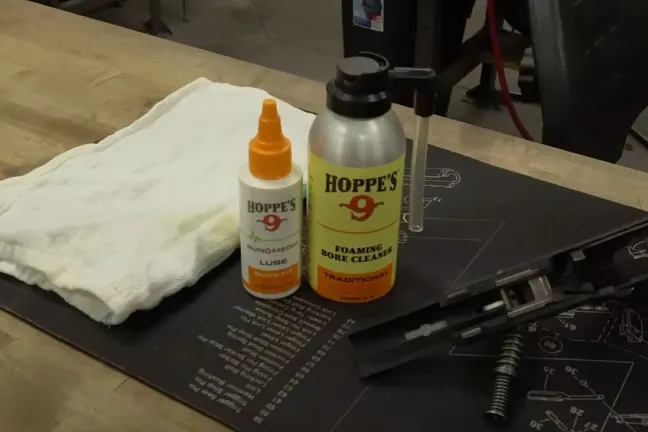
Choosing Powder Solvents
For a deep cleanse, especially after heavy use, the right powder solvent is indispensable. Renowned choices like Hoppe’s No. 9 stand out for their potent ability to dissolve stubborn gunpowder residues, leaving your barrel immaculately clean and ensuring unimpeded performance.
The Role of Household Cleaners
While not conventional, certain household cleaners, such as 409, can be ingeniously repurposed for firearm cleaning. However, this approach necessitates caution to avoid potential damage, underscoring the importance of understanding your firearm’s materials and finishes to ensure compatibility and prevent harmful reactions.
Soap and Water Basics
The simplicity of soap and water, especially effective for cleaning black powder firearms, offers a gentle yet effective means to eliminate residues without resorting to harsh chemicals. The key to this method’s success lies in meticulous drying post-cleaning, to thwart any onset of rust.
Disassembling the Firearm
The Importance of Disassembly
Comprehensive cleaning begins with a thorough disassembly of your firearm. This critical step ensures access to otherwise concealed areas, enabling a more thorough and effective cleaning. Disassembling your firearm not only facilitates a deeper clean but also acquaints you with its mechanics and intricacies, enhancing your understanding and proficiency in its maintenance.
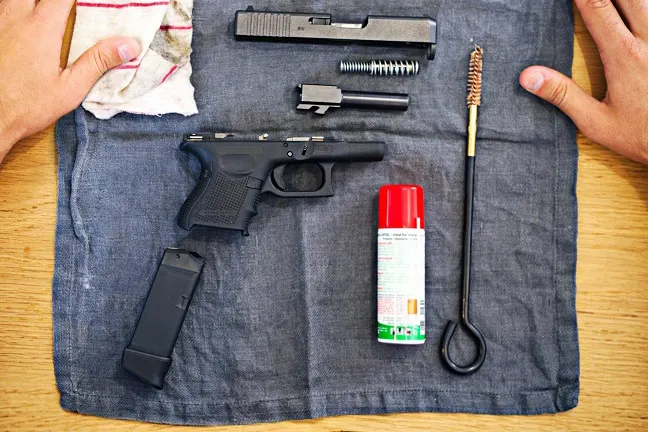
Pre-Cleaning Inspection
Initiating the cleaning process with a detailed inspection of your firearm can reveal signs of wear or damage that might necessitate special attention. This proactive measure helps in identifying potential issues early, allowing for targeted cleaning and maintenance efforts where they are most needed.
Cleaning the Bolt Carrier Group
Removing Residues
The bolt carrier group is a common repository for residues due to its central role in the firearm’s operation. A targeted clean with CLP, aided by a robust brush, effectively dislodges and removes accumulated build-up, ensuring the smooth functioning of your firearm. This step is crucial in maintaining the reliability and efficiency of your firearm’s action.
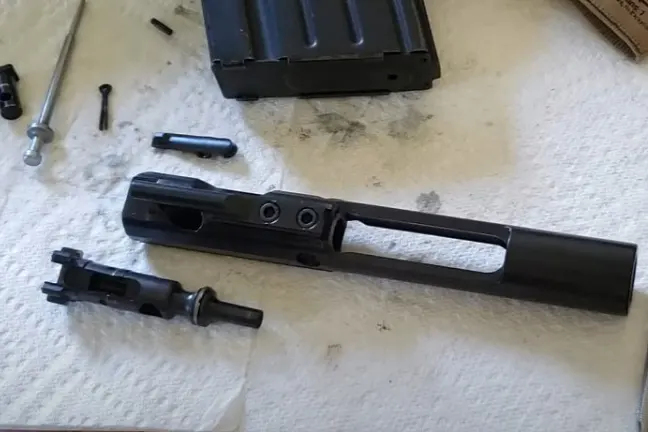
Paying Attention to Detail
Addressing the hard-to-reach areas within the bolt carrier group is where q-tips and pipe cleaners prove their worth. These tools enable meticulous cleaning of crevices and recesses, ensuring that no residue remains to hinder the operation or compromise the cleanliness of your firearm.
Cleaning the Charging Handle
Maintaining Functionality
The charging handle’s propensity to accumulate grime can adversely affect its functionality. A thorough cleaning using soapy water, followed by a rinse with clear water, restores its smooth operation. Regular maintenance of the charging handle is pivotal in preventing malfunctions and ensuring the reliable operation of your firearm under all conditions.
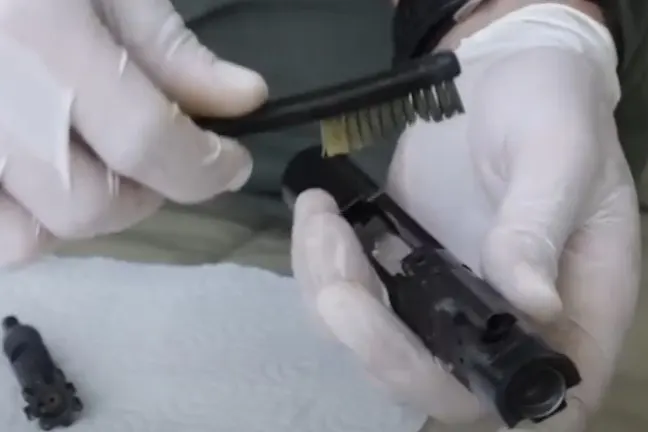
Regular Checks
Instituting regular inspections of the charging handle for accumulated grime and wear is crucial in averting potential malfunctions. Such preventative maintenance is instrumental in upholding the firearm’s reliability, ensuring it performs optimally when needed.
Cleaning the Upper Receiver
Tackling Hard-to-Reach Areas
The upper receiver’s complex design presents unique challenges in cleaning. Employing an array of tools, including specialized brushes and CLP, allows for effective cleaning of this component. Addressing the upper receiver’s intricacies ensures a comprehensive clean, safeguarding the firearm’s performance and longevity.
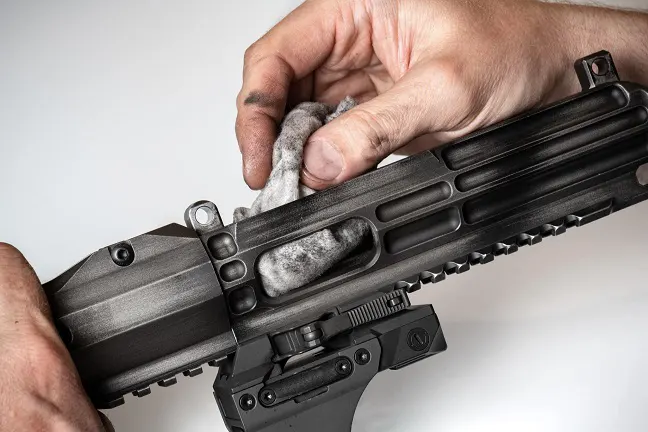
Focus on Residue Removal
Concentrating on areas prone to residue accumulation, particularly within the bolt carrier group and the chamber, is vital. Cleanliness in these areas significantly influences the firearm’s overall performance, underscoring the importance of thorough maintenance for optimal operation.
Cleaning the Lower Receiver
Intricate Part Attention
The lower receiver, with its array of small and intricate components, demands a delicate yet thorough cleaning approach. Utilizing the appropriate tools and cleaning solutions ensures these critical areas are maintained without risk of damage, contributing to the firearm’s overall functionality and integrity.
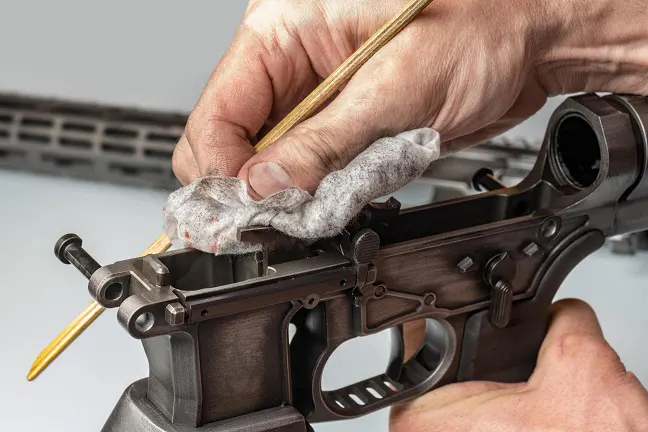
Ensuring Operational Integrity
A clean lower receiver not only enhances the firearm’s appearance but is crucial in maintaining its operational integrity. Regular cleaning prevents malfunctions caused by accumulated dirt and debris, ensuring the firearm’s reliable performance.
Bore Cleaning
Key to Accuracy
Maintaining a clean bore is paramount for the accuracy of your firearm. Employing a bore brush along with a suitable solvent facilitates the removal of fouling and residues, preserving the precision and effectiveness of your shots.
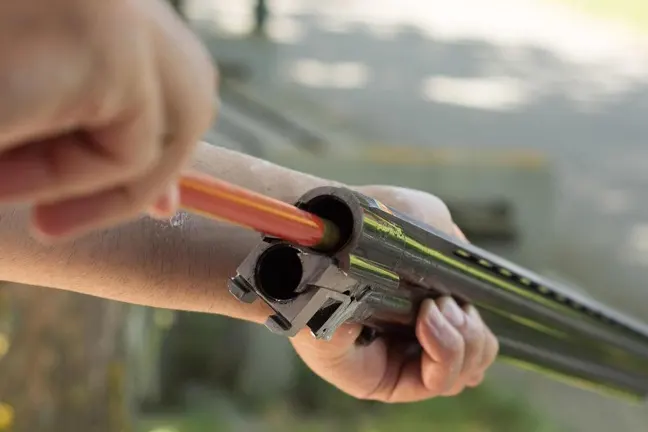
Step-by-Step Bore Cleaning
- Start at the chamber end of the bore.
- Progress towards the muzzle using a solvent-soaked brush.
- Dislodge debris by moving the brush through the bore.
- Repeat the process several times for thorough cleaning.
- Switch to a cleaning patch to remove any remaining debris.
- Ensure the bore is thoroughly clean to maintain the firearm’s accuracy.
Drying and Reassembling
Drying
Ensuring that each component of the firearm is thoroughly dried following cleaning is crucial in preventing rust and corrosion. Options such as air drying in a well-ventilated area or using a clean, dry cloth are effective in achieving a moisture-free state before reassembly.
Careful Reassembly
The reassembly process demands careful attention to detail, ensuring each part is correctly positioned and functional. Consulting the manufacturer’s manual for guidance and thoroughly checking each step is key to a successful reassembly, ensuring the firearm’s reliability and readiness for use.
Lubrication
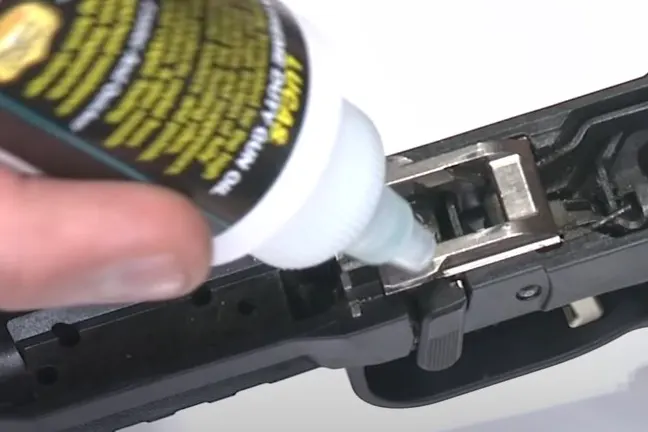
Applying Lubricants Correctly
- Identify Key Lubrication Points: Focus on areas where there is movement and friction, such as the bolt carrier group, slide rails, and any moving parts within the trigger mechanism.
- Apply Lubricant Judiciously: Use a small amount of lubricant on each key point. A drop or a light coat is often sufficient.
- Use Appropriate Lubricants: Choose lubricants specifically designed for firearms to ensure compatibility and effectiveness.
- Avoid Over-Lubrication: Excessive lubricant can attract dirt, dust, and debris, potentially impairing the firearm’s function. Apply sparingly.
- Spread Evenly: After applying, spread the lubricant evenly with a clean cloth or brush to cover the surface area without pooling.
- Wipe Away Excess: Use a clean cloth to gently remove any excess lubricant from the firearm’s surface to prevent dirt accumulation.
- Regular Maintenance Check: Periodically check lubricated areas to ensure they remain adequately lubricated and free from debris accumulation.
Choosing the Right Lubricant
While CLP offers a convenient all-in-one solution, selecting the right lubricant may depend on the specific requirements of your firearm and the conditions in which it will be used. Tailoring your lubrication choices to these factors ensures optimal protection and performance.
BEST Gun Cleaner and Lubricant for the Money
Function Check
Ensuring Proper Functionality
A thorough function check post-reassembly is imperative to verify the correct operation of all firearm components. This essential step confirms the firearm’s safety and readiness, providing peace of mind in its reliability.
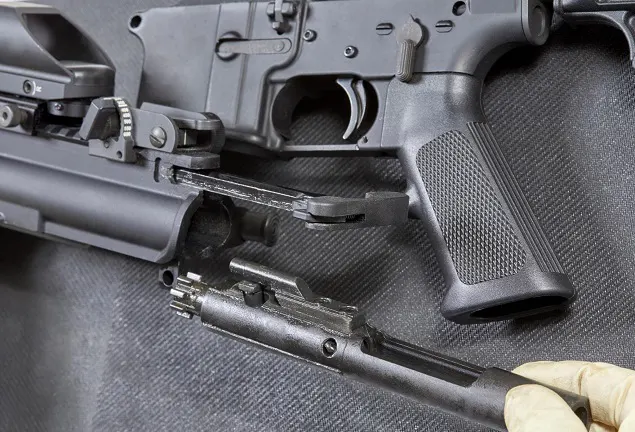
What to Check
- Verify the smooth cycling of the action.
- Check the correct operation of the safety mechanism.
- Ensure the proper functioning of the trigger system.
- Address any discrepancies immediately for safe and effective firearm use.
Cleaning Other Firearms
Adapting the Process
While the foundational principles of firearm cleaning remain consistent, different firearm types may necessitate tailored approaches. Recognizing and adapting to the unique requirements of each firearm ensures a thorough and effective cleaning, preserving the functionality and longevity of your collection.
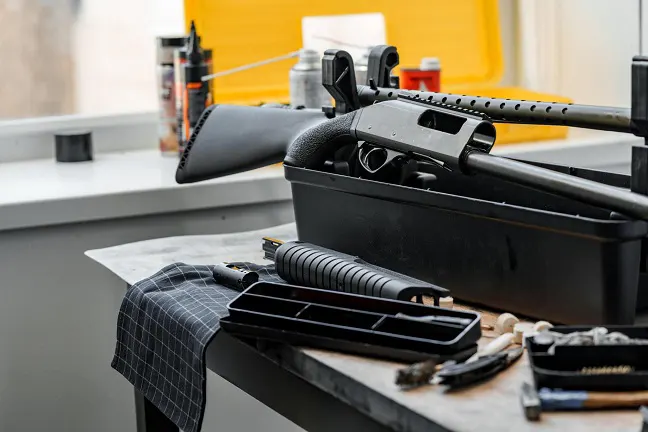
Special Considerations
The diverse world of firearms, from revolvers to shotguns, presents unique cleaning challenges. Customizing your cleaning technique to accommodate the specific design and maintenance needs of each firearm type enhances the efficacy of your maintenance routine, ensuring optimal care for your entire arsenal.
Safety and Maintenance Tips
Prioritizing Safety
The paramount importance of safety cannot be overstated when maintaining firearms. Ensuring that the firearm is unloaded and establishing a designated cleaning area free from distractions and ammunition are critical safety measures that must be adhered to.
Regular Maintenance Schedule
Committing to a regular cleaning schedule, whether after each use or at predetermined intervals for stored firearms, is key to preventing potential issues and prolonging the life of your firearm. Consistent maintenance is the foundation of reliable firearm performance and safety.
Conclusion
The discipline of firearm cleaning is an integral aspect of responsible gun ownership, vital for ensuring the safety, reliability, and longevity of your firearms. By following this detailed, step-by-step guide, you can maintain your firearms in exemplary condition, ready for whatever challenges or opportunities arise. Remember, a well-maintained firearm is not just a tool; it’s a testament to the owner’s commitment to excellence and safety.
FAQs
- What is CLP, and why is it important in firearm maintenance?
- CLP stands for Cleaner, Lubricant, Preservative. It’s crucial in firearm maintenance because it offers a three-in-one solution that cleans fouling, lubricates moving parts to prevent wear, and provides a protective layer against rust and corrosion, simplifying the maintenance process.
- Can household cleaners be used for firearm cleaning?
- Certain household cleaners can be repurposed for firearm cleaning, but caution is advised. It’s essential to understand the materials and finishes of your firearm to ensure the cleaner won’t cause damage. Always test in a small, inconspicuous area first.
- How often should I clean my firearm?
- The frequency of cleaning depends on how often the firearm is used and the conditions in which it’s operated. As a general rule, cleaning after every use is recommended to prevent buildup and maintain optimal performance. For firearms in storage, a regular maintenance schedule, such as quarterly cleaning, is advisable.
- Why is disassembling the firearm necessary for cleaning?
- Disassembling the firearm allows for a more thorough cleaning by providing access to areas that are not reachable when the firearm is fully assembled. This ensures that all parts, especially those prone to residue buildup, are properly maintained.
- What are the risks of not cleaning my firearm regularly?
- Neglecting regular cleaning can lead to a buildup of residues and fouling, which can cause malfunctions, reduced accuracy, and increased wear on components. In extreme cases, it can lead to corrosion and irreparable damage to the firearm.
- How do I choose the right lubricant for my firearm?
- The choice of lubricant can depend on the specific needs of your firearm and the environmental conditions in which it will be used. While CLP is a versatile option, specialized lubricants may be needed for extreme conditions. Consult your firearm’s manufacturer or a professional gunsmith for recommendations.
- What tools are essential for a basic firearm cleaning kit?
- A basic firearm cleaning kit should include cleaning rods, bore brushes suitable for your firearm’s caliber, a general cleaning brush, CLP or a specific cleaning solvent and lubricant, q-tips, pipe cleaners for intricate spaces, and cleaning patches.
- Is it necessary to clean the bore every time the firearm is used?
- Yes, cleaning the bore after every use is important to remove residues and prevent fouling buildup, which can affect accuracy and overall performance. Regular bore cleaning ensures the barrel remains clear and free of obstructions.
- Can improper cleaning damage my firearm?
- Yes, improper cleaning techniques or the use of unsuitable products can cause damage to your firearm. It’s crucial to follow recommended cleaning procedures and use products that are safe for your firearm’s materials and finishes.
- What should I do if I notice wear or damage on my firearm during cleaning?
- If you notice signs of wear or damage during cleaning, it’s advisable to consult a professional gunsmith for an assessment and possible repairs. Continuing to use a damaged firearm can be unsafe and may lead to further damage.
Latest Post
Weekly Newsletter
Do you want to get notified when a new article is added to Guncritic? Sign up for our newsletter and you'll be among the first to find out about new articles and reviews.
Comment